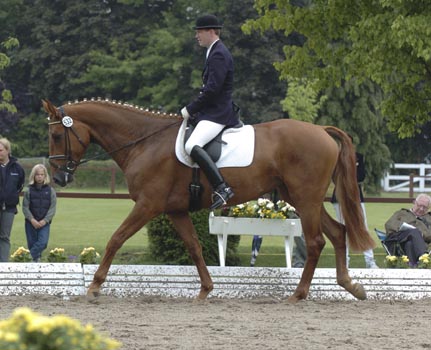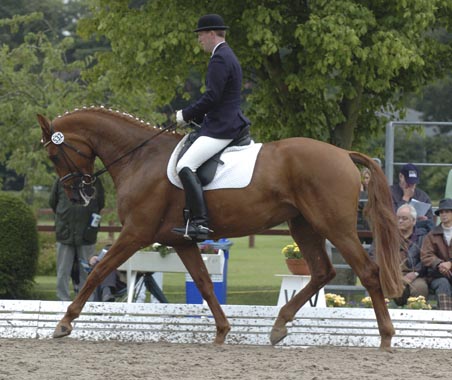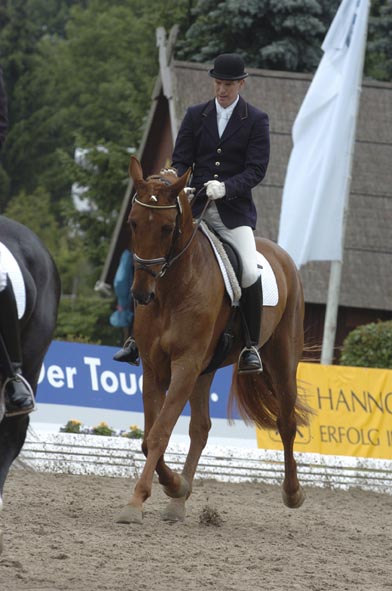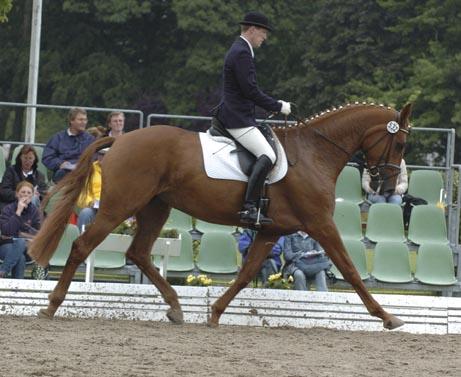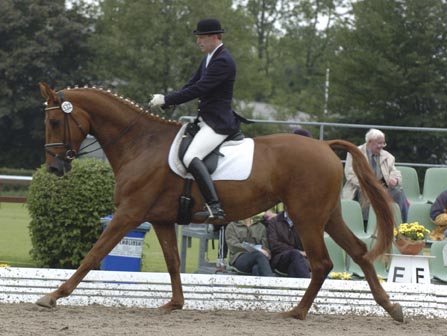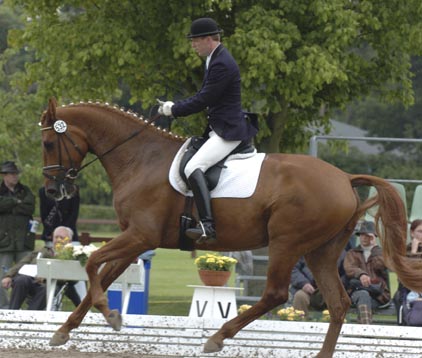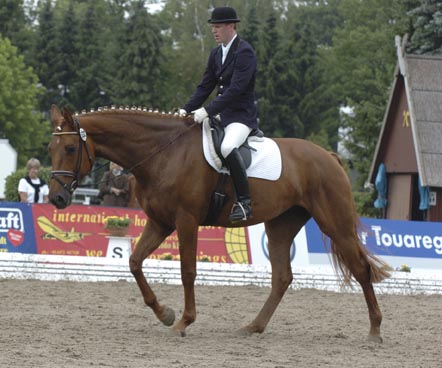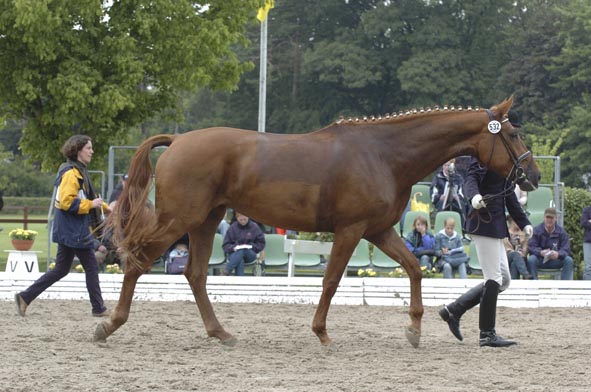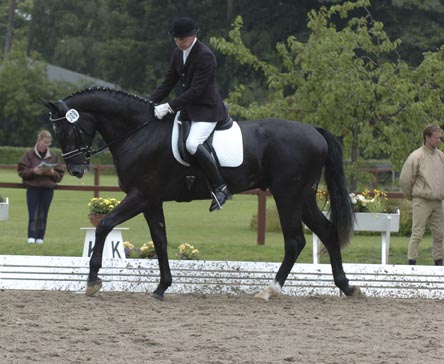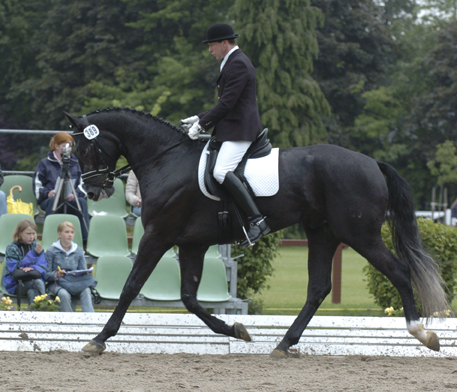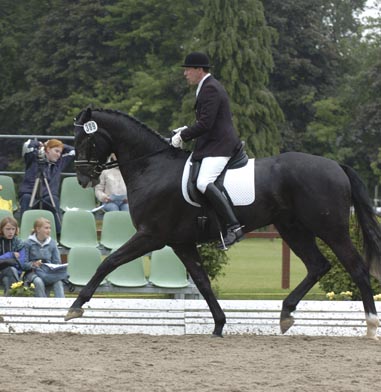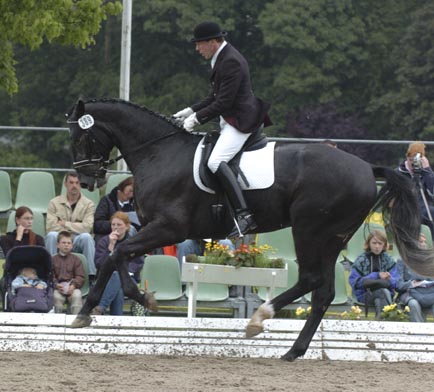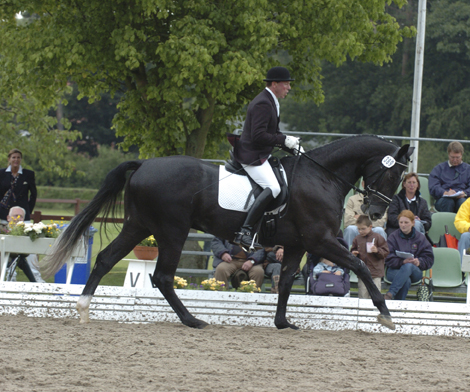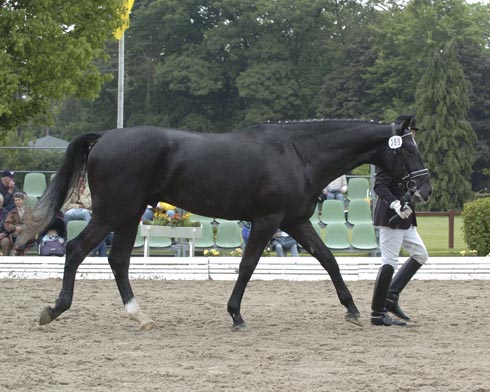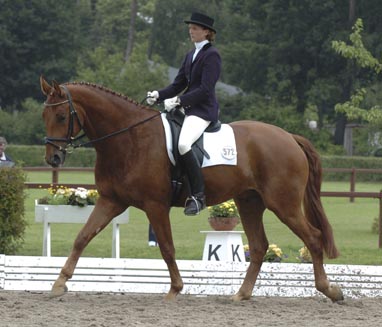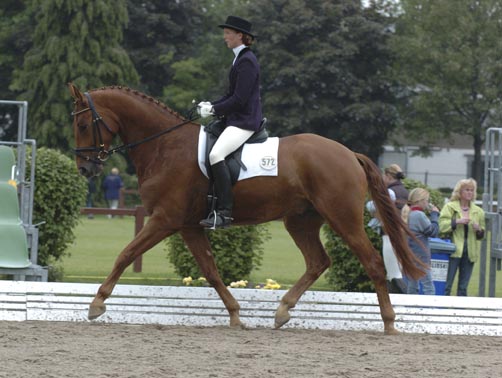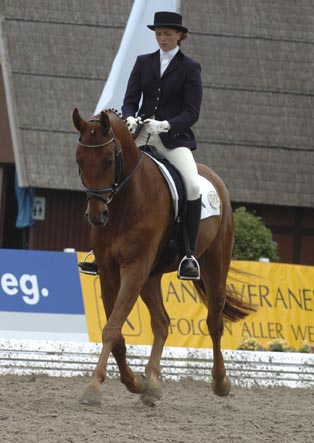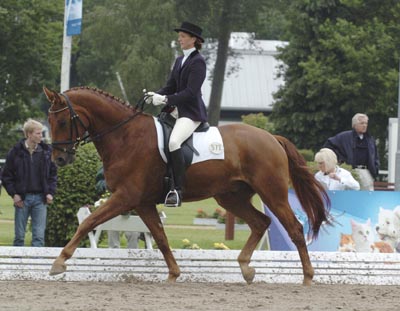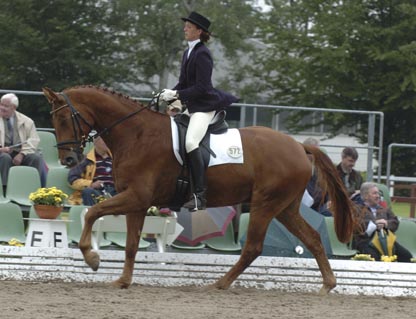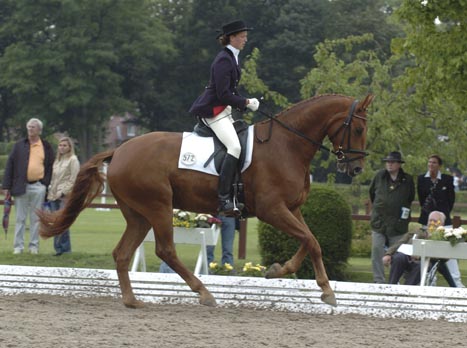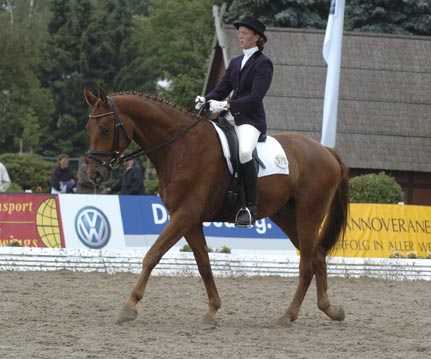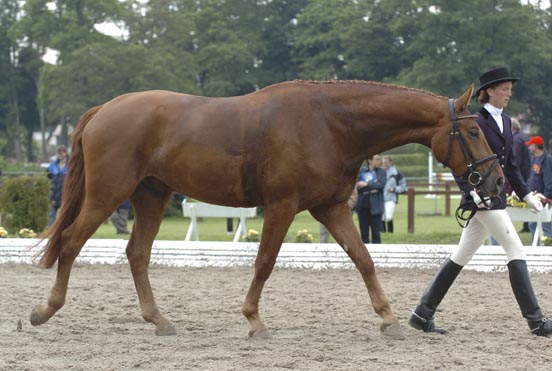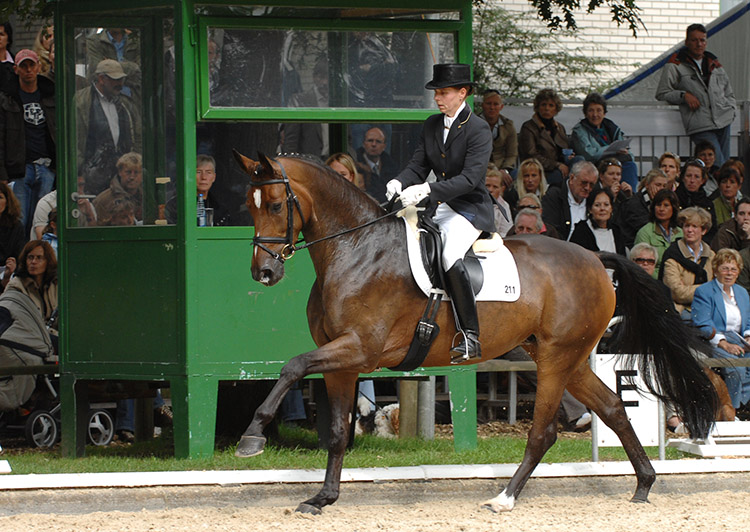
Susan riding Cayenne W as a six-year-old at the Bundeschampionat. The mare was sold, and she went on and competed at Grand Prix level.
Susan Draper is one of the riding world’s little secrets. In Germany, Susan is widely known and respected as a wonderful rider and in particular a producer of young horses. She is not so well known in the rest of the world, perhaps because she doesn’t fit neatly into any national team. Born in Holland of English parents, she retains her British nationality but lives with her partner, Ingo Pape at the famous stud farm established by Ingo’s father, Günter.
Visit the Hengst Station Pape any morning and you will find the pair of them at work with the stallions. After the semen is collected, the stallions come into the hall to be worked, and it is sheer joy just to sit in the corner watching a superb display of horsemanship on some of the world’s greatest dressage stallions. Both Ingo and Susan trained with the great Herbert Rehbein, and their work is clean and classical. They apply the same principles to their young horses. If they have a youngster that is happily handling the work, then they will take it to the Bundeschampionate – but this is not one of those Bundeschamp ‘crash course colleges’ where the youngsters are jazzed into an artificially induced brittle brilliance. Indeed, despite her success with horses in the 3 and 4 year old ‘material’ classes in the past, Susan has given up on riding in them, preferring to concentrate on the five and six year old Young dressage horse classes.
Still it is fascinating to sit back and listen to Susan Draper as she discusses the merits and demerits of this class of 4 year olds. Interesting particularly to note how strongly Susan emphasises the role of the rider in producing a top class impression – and a happy horse!
“With this horse I would first try to get her used to the arena. Especially if you have a horse that is very tense, try to pat him and get him used to it. Some horses just start panicking or they close their back and they get very tight. I think it is very difficult for a young horse, especially when they come in, especially when they say ‘start in walk’. Sometimes it is easier for a young horse when you can trot for maybe a lap.”
“In this photo, the frame is very nice for the walk, maybe the seat of the rider is not so ideal, but definitely the horse has her nose in front of the vertical and looks like she has a relaxed back. I think the horse herself looks good, maybe the rider could improve.”
“The rider should keep his leg a bit longer, heels down and shoulders back, but the contact is good, the horse is chewing, her mouth is white and relaxed, not open. Especially when a young horse has a very good walk, it is always dangerous to really collect them, it is easy for them to get the walk mixed up, especially when they have a big walk.”
“Here the horse is definitely behind the vertical. Of course it is always difficult for a young horse to be in balance 100% throughout a test. Her back doesn’t look tight, but the rider should try and release more in front, give and take, and push her to the contact more. If he would push more, and give the reins more, then the horse would reach more.”
What are the points to think about when riding a diagonal in these sorts of tests?
“Some of the riders when they are in front, are at the horse; chase, chase, like full trot, and some horses can’t do that. They get longer and longer, and they start running – they don’t have their swinging trot any more. Of course the four riders have to sort of keep together, but if I see that I am closing up too much, then I would ride the diagonal a bit to one side of the line, to make more space. Of course when you are in front, then you can make your own pace.”
And if you find your horse is getting a little left behind?
“Of course this is a material class, it is not like a dressage test, you can sneak off the track a bit, and make the circle smaller – of course if the horse is getting lazy, then I would try and push him more.”
“This horse is again behind the vertical, the rider should keep his hands a bit lower, the lower arm should always be in a line with the rein. A high hand is always a bit hard, so I would keep my fists lower, and try to get her a bit more out in front.”
What’s happening here, do you think he was trying to do what you said?
“At this moment he is giving and taking the reins, uberstreichen we call it, you can definitely see that the horse is nicely on the bit in this picture, she is not nervous, her ears are pricked. Maybe this picture is not so ideal to see how the canter itself is, but definitely the horse seems very happy in this moment. Always try to ride the horse uphill – have the feeling that you are riding up a hill. It is difficult when you are in a group – if you are in front, that’s fine, but in a group, they can get tense. I’ve had this experience many times – personally I don’t ride these tests any more, unless I have a horse that is really laid back and he can cope with anything. Especially with horses with a bit more Thoroughbred, or a little hotter, which is super for later, but for these material classes it can be very difficult.”
“Here you can see that the horse has a very big framed canter. Her hind leg is right up under her centre of gravity, she uses her joints, her hocks. Once again, I must say the rider should keep his hands down. I guess at this point he wants to show that his horse has a good canter, so he is pushing her, so maybe that is why she has her ears back. She is definitely cantering uphill – it looks good.”
“It is the same on the left lead. The going was very deep, and I think when you ride a young horse for 20 minutes, really pushing them, there is a point where they get very tired. You can see the rider pushing in this photo, but the canter itself looks very pleasant, and again, she is using her joints. The front leg could maybe have more freedom in the shoulder.”
“This is a nice relaxed walk. A good long frame, you are not suppose to throw the reins away and ride on the buckle, there should always be a contact. As far as I can see, the rhythm of the walk is good, nose in front of the vertical. The frame can’t be any bigger, so that is very good walk.”
“The type is maybe a little bit old fashioned, she could have a more elegant head, more feminine, the shoulder could be a bit more sloping. She looks as though she has a very good back, the hind leg is very good actually, but overall she could be a bit more modern and more elegant.”
“This wouldn’t make a great first impression on the judge, it doesn’t look good if you come in looking like this… it’s too rolled up and it looks as though the walk is very short, and the rider is… almost falling off!!! If a horse gets very tense, I know that feeling, especially if you have a stallion, there is just nothing you can do. You have to pat and talk, try to make the best of it. It’s young horses – and especially with these types of test, it’s just what happens on the day.”
“This horse definitely goes very much on the forehand. You can see that the rider is literally pulling in order to keep him controlled, and once you start pulling, then as you can see, his hind legs are still in his stable. The more you pull the more horse gets on the forehand. He hasn’t got a very round trot, over the knee he looks very stiff. But then again it is because the rider is pulling and sitting forward – the horse should definitely be more in front of the vertical and more on his hindlegs.”
“The horse looks tense. It’s not ‘oh I like this horse’ – there should be some sort of an eye catcher. The rider is just having a hard time keeping it together… just thinking, ‘I hope this is going to be over soon!’”
“The horse’s shoulder still looks very stiff, and you can see that he is not carrying himself. Even a young horse should have his balance and carry himself. Today the horse is very tense, very tight – and that is not what the judges want to see, a horse with a tight contact, especially in a young horse class. There is a red line that goes through all these pictures, and it is because the horse is not on his hind legs, his joints are not working, the rider is just sitting on his thighs, not sitting relaxed and going with the horse. The rider should be trying to say ‘okay, it’s not so bad’. His reins are too short, he needs to make the reins longer and sit back more and relax his shoulders and try to sit. And try to pat the horse, even in the test.”
“Oh… well he’s really pushing for it, and going, but the horse has a high croup and again, he is behind the vertical. It looks as though he doesn’t have such a big canter, it doesn’t have such a big stride, maybe it’s uphill, maybe there is great speed, but it is not really lengthening. Here he just looks short with a fast rhythm.” “The rider should watch that he doesn’t fall off. That comes into the score too, the general impression, the seat of the rider – okay it doesn’t need to be a 9 or a 10 like Ulla Salzgeber, but if you are going into a test like this, you should be trying to look good…”
“Here you can finally see that the horse does have a longer neck and a nice frame. The rider should try in the test in the trot and the canter to make the neck longer. Okay if they get hot there is nothing you can do, but you can see that the horse has a nice neck it’s just that in the trot and canter it didn’t show. The walk is maybe a bit short, it’s hard to tell, he could have more from behind to get him over-tracking. It looks as if he is sort of relaxed, maybe the rider should try to have lighter contact.”
“Here we see he is definitely nicely muscled up. Maybe he could have a nicer eye. A horse should have a clear, big black eye. He is a little high in the croup, the shoulder could be a bit better. I think he is a nice horse but not a top horse.”
“This is much much better, the horse has a very nice uphill neck, the rider has a nice contact, even though her seat is much better than the ones we’ve seen before, she should try to sit straight, hands closer together, and put her hat more into line. The horse seems to be very happy and has a good stride, so all is good… so far.”
“It looks like the horse has a very good rhythm, there is a good contact. He is not pulling – he is not hard, and he is not too loose. It seems as if the horse is going from his hind leg, over his back, to the mouth, he is definitely more on his hindleg. I can’t tell about his shoulder freedom, it looks okay. Maybe the rider could have her heels deeper and her toes turned in more, her shoulders back, and she should definitely look for a new hat.”
“The picture looks fine, the horse looks very relaxed and happy. The rider should maybe try to keep her hands lower, and she should keep her hands in front of her hips. In this moment it is a fine picture.”
“Now the horse. He has a very nice front end, nice neck, the nose… it’s okay, maybe if you want to be very critical, it is a bit behind the vertical, but it is still okay. Maybe he could be more from behind, maybe at this point she was trying to do too well, and was over-doing it. If the judge says ‘medium trot’, even in the test, the rider should on the short side, collect him a bit, get him more on his hind end, then let the strides out. Here it looks as though the hind leg is slow. Maybe she wanted to do too much, more than the horse can do.”
“Some riders in the front, they just go, it’s like being on a racetrack, then they are over-doing the horse: I would try to use the short side, get the horse on the hind leg when the judges are not looking, ok one stride sitting trot, you are not ‘allowed’ to, but, get him closer together, give and take half halts, and then when they say ‘medium trot’, you have him, you can release better, and get that better bigger stride.”
“Is this canter or is it rising canter? I don’t know what she is doing here. I don’t know if her horse is hard to sit or he’s jumping away. This is not such a nice picture, she is literally standing up, maybe he was getting hot at this point, and she was trying to regulate it with her hands rather than try to sit more, and get him more in front of the vertical.”
“It is always a mistake to try and regulate the horse with your hands. The other problem you see, with riders who are not very experienced, they practice big trots and canters all the time. They ride medium and extended trot, and it wears the horse out, and the horses get longer and longer and longer. Three and four year olds don’t need to be ridden every day. Better to go and ride through a forest, rather than going to every young horse class every weekend, and racing and racing – eventually they say ‘that’s it’ and they are not with you any more. Then they get hot or they get tense, then the riders start swinging on them.”
“This is a much much better picture. Maybe the picture we saw before was not typical, although the rider was definitely standing up and you can still see here that she is sort of standing up, the horse seems to cope with it very well. She should definitely sit back more – as though you are leaning against a chair with your back, keep your legs long… you can see her upper and lower arm is stiff. I don’t know why because the horse looks very good, she is very stiff and like ‘oh my goodness I have to do this very well… she should relax a bit more.”
“The canter itself is very good. The rider is still trying to regulate the canter with her hands, but you should always ride the horse from behind. It’s like I said, the horse is maybe better than the rider.”
“In walk he has an okay stride, it seems he is over-tracking enough. He looks very happy and he has a nice frame. The rider needs to close her knees a bit more, then her lower leg will also improve. Her hands could maybe be lower and relaxed, saying ‘it’s okay, it’s okay’. But the horse looks very happy.”
“It’s a very interesting horse. He has a very big frame. I wouldn’t particularly say, this is a material class horse. I’d like to see this horse later, maybe 6, 7 years old, because nowadays when you see these Bundeschampionate horses, they are all super types, real eye catchers. This horse has a nice neck, good shoulder. Maybe the face could be a bit more elegant. Definitely an interesting horse.”
Having looked at all three are you happy you made the decision not to ride in material classes?
“The last horse I rode in material classes was Baroncelli. I had a very hard time in Warendorf with him as a 4 year old. He was just very distracted by everything that was happening around him. We had to come in at walk, and generally he has a very good walk, but when I got in there, I couldn’t do anything. I decided this is the last time… I really like to watch it.”
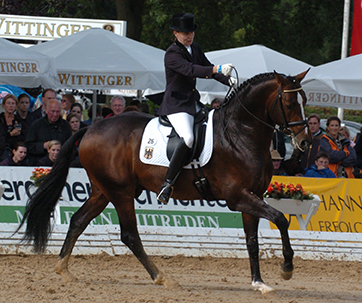
“Riding five and six year old classes – that’s what counts. Those classes tell me much more than those material classes for three and four year olds – just big trots, big canters, at the end of the day, we have to try and collect these big movements. It’s much more important to see what they can do when they are five years old – four year olds is just racing around the track. Like I said, I like watching it, but I’m not a fan of riding in those classes.”
“I think about a horse like Duvalier – now he is going Grand Prix. But when I tried to ride him at the Bundeschampionate, obviously he had qualified to get there, but when I came into the arena at Warendorf, they were calling out the scores from the previous group and the crowd was cheering, and there was no walk – there was only piaffing. I think I got a 5! There’s nothing you can do in that situation – but it is what they do when they are older that counts. He does Grand Prix.”
Do you think it hurts or helps to show them at that young age?
“With Duvalier I shouldn’t have done it, that was my mistake. I think it is good for the young horses if you take them to shows, but if you are selected to go to the Bundeschampionate, you have to have a horse that is super super clear in his mind. You have to be sure he can cope with everything – with ponies, jumpers, crowds, food stalls, kids playing, and then you are still going to need a lot of luck.”



